Cairo Sunset
For nearly four years, the entry for this quilt said: "A placeholder. I'm working on it but haven't written it up yet. Sorry!"
It's time to really write it up, and that requires some trawling of my inbox, eBay records, and archived Flickr photos.
In January 2010, emails back and forth between Jacob and me indicated interest in Egyptian fabrics for a possible quilt for his mother. No action happened until July 2010, when another email exchange between us indicated that I had started looking seriously at fabric, and uncovered a problem that haunted us throughout the creation of this quilt. Emphasis mine:
First, I have made a couple of purchases. Project temporarily codenamed Blue Lotus. (link)
Now, here's what I need. I've been scavenging, and seriously, we are out of phase with the times, because nobody's doing this sort of thing right now. Here's what I'd like to ask you to do relatively quickly:
1) Scan over those fabrics I've bought.
2) Take a look at this ebay link; this seller has a few fabrics that coordinate with what I've already bought, and I have a standing order with this person I haven't paid for yet. I've requested a total, though, so I've got a little time.
Sourcing the fabrics for this quilt was eye-opening for me. I'd previously held the nebulous idea that any design I wanted to do could be found in quilting fabric if I looked hard enough, and it didn't prove to be the case here. We simply couldn't find Egyptian-themed fabrics, and we didn't understand why at first. I began to realize how carefully-curated the world of quilting fabrics is; if a type of design isn't currently in vogue, it's unlikely to be available. You may think your giant fabric stores have everything, but I'd challenge you to do what we did: walk in, and look for Egyptian-themed fabrics.
We'll wait.
We'll be here when you come back empty-handed.
(To be fair, Robert Kaufman released "Valley of the Kings" in 2010, and you might find some of it in stores still. But that's all you'll find.)
The answer is, of course, the secondary market. Resale shops. Etsy. Ebay. Swapping with other quilters. Quilters buy fabrics they like (because they understand on an instinctual level that fabric lines go out of print, and you'd best snap up what you love while it's available) and stashed fabrics either get used or trickle out into the resale market over a number of years. Fortune favors the patient, in our case.
We didn't find yardage. Instead, we began a months-long dig to find anything and everything Egyptian-themed, frequently sourcing interesting fabrics a quarter-yard at a time from individual sellers. We got savvier in our searches; sometimes it would be listed as "African," and sometimes "Egyptian." We eventually acquired enough quarter-yards to start piecing together selvages and figuring out what lines of fabric we were unknowingly attempting to reconstruct. We bought anything we loved, and trusted we could sort it out later. When I found 6 yards of suitable backing from a British eBay seller who didn't ship internationally, I arranged to have the fabric shipped to a British friend, who then re-shipped it out to me.
After a while, Jacob and I began to joke that we were probably sitting on the single largest stash of Egyptian-themed quilt fabrics in the continental United States. As the pile grew, we realized we could sort them into two piles: a green-toned pile, and a reddish-toned pile:
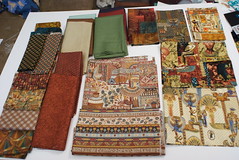 The red fabrics
The red fabrics
and 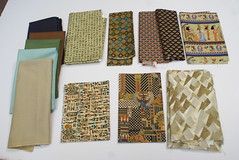 The green fabrics
The green fabrics
The green-toned fabrics were diverted off into a lap quilt called "Papyrus," which was finished several years ago. The red ones, however, would have to wait.
So why was it so hard to source these fabrics in 2010? Egyptian prints have not been in favor for some time. Prior to Robert Kaufman's 2010 line, there hadn't been much printed in the previous 15 years:
- Alexander Henry did a "Valley of the Kings" line in 1996. (~14 years)
- Alexander Henry also released some Egyptian fabric with a copyright date of 1993. (~17 years)
- Blank Textiles did "Luxor" somewhere around 2003. (~7 years)
- Woodrow Studios printed a line for the British Museum, "Eternal Egypt," sometime in the 1990s. The company went out of business, and I could never find more info about when it was printed. (~15 years)
- Makower did a line including fabrics called "Nile Valley Stripe," "Nile Mosaic," and "Nile Valley Mural," date unknown
- Hi Fashion Fabrics (for Timeless Treasures) did a "Sphinx" collection, date unknown
Since Jacob was in Minnesota and I in Alabama, I photographed each acquisition and gave information on it, in case we wanted to attempt finding more fabric to match. Individual photos are available in the full photoset for this quilt for the terminally curious, but they eventually condensed down into:
That was late July of 2010. After Jeff's accident five months later, this idea was completely shelved. It went into the topmost drawer of my in-progress bin.
Unbeknownst to me, the guilt began on April 27, 2011. Meteorologist James Spann sums it up well:
The April 27th Alabama tornado outbreak was generational. It is rare to have that many strong/violent tornadoes in one day, killing that many people. What made it especially unique was the morning round of storms, which was a disaster in itself. Five people were killed as the sun was coming up, and over a quarter million Alabamians had no power. As that settled down by mid-morning and the sun was returning, we knew the powder keg would explode later in the day when the main energy arrived. And, we also knew getting word out would be especially difficult due to the widespread nature of the morning power outages.
The first afternoon storm exploded in intensity, and produced a tornado that we caught live on our Skycam in Cullman, Ala. When your first storm of the day produces a strong/violent tornado, you know the stage is set for real trouble. It was about eight hours of non-stop tornado warnings, almost like the state was dodging bullets from hell. There were times I was tempted just to let the live video of these killer tornadoes speak for themselves, but I couldn't do that because so many were listening on radio due to the power outages. Words didn't always come easily.
It totally took our breath away. It was truly a once in a lifetime event.
(Southern Living: "How Was This Storm Different")
An F5 tornado passed within a half-mile of my home, doing tremendous damage to my community. My quilt kitty Tenzing had had his first cardiomyopathy spell that morning, and Jeff was still not well enough to live at home, so Tenzing's littermate Edmund and I rode it out together at home:
We were out of power for a week afterward, since the tornado severed the main lines to the power plant that provided electricity to all of northern Alabama. I treated it as suburban camping, and cut quilt fabric at night by candlelight, listening to the northern Alabama radio stations do community service by broadcasting 24/7 news, updates, and requests for help to northern Alabamans who, like me, chose to ride out the time of no functioning gas stations or cell phone towers. I wanted to work on this quilt, but couldn't, because the quilt pattern ("mod mosaic") that Jacob and I had chosen required machine-sewing, and I had no way to do machine sewing in the 8-9 days I was without power. So, only fabric cutting and hand-sewing was done:
Over time, the guilt nibbled at me: what if the tornado had hit my home instead of a half-mile down the road? All the intention in the world didn't make a finished quilt. Only effort did, and what I had in the top drawer was nothing but plans.
Time continued to pass. In order to support the changes that Jeff's accident required, I took a new job in October 2011 that allowed me to work from home, but caused me to incur a significant amount of travel. The quilt couldn't be worked on from the road, and so it continued to sit.
Time continued to pass.
As I packed up my sewing room in November 2013 in preparation for moving to Oregon, I found the pieces -- all carefully stowed in the top drawer -- and chose not to ship them to Jacob. I kept them with me. Surely this life in Oregon would allow this quilt to be finished.
Time continued to pass.
Eventually, on his third trip to visit me in Oregon in January 2015, Jacob and I agreed that it was time to knock this project out. We scheduled a week of vacation together, and made no plans except sewing. I cleaned my sewing room, and once cleaned, I emptied my top drawer onto my sewing table. I looked at what had been bought years ago, and it felt like it had come from another life: married, living in Alabama, two littermate cats. I pulled it out in my quilting studio in Oregon, a single woman who had lost both previous cats to old age and adopted two more, and then pinned up the quilt schematic. It was time to make this project right.
 Cairo Sunset, with grids and sizes
Cairo Sunset, with grids and sizes
We got to work making a right royal mess. Mosaics require large quantities of source material.
I drove the sewing machine. Jacob chose fabrics and laid out each of the mosaics. I served as the hands to make his ideas come to life, and I was grateful for it, because his color sense is stronger than mine. He insisted from the start that each of the mosaics have a focus fabric, showing off the best portions of the fabrics we'd struggled to source:
He was right. As the mosaics came together, the focus fabrics helped the mosaics feel balanced, instead of overwhelmed with tiny pieces:
As the week went on, our efforts intensified. We both had the sense we could finish the 90" x 100" top if we kept our level of effort up, and by Thursday night, we were starting to audition the fussy-cut focus squares we intended to run across the bottom and top of the quilt:
We finished the top on Friday morning, after a multiple-hour effort to get all of the focus squares arranged and placed. My neighbor Mary was kind enough to take a photo of us next to the quilt in my living room, which gives you an idea of scale. (I am 5'1" and Jacob is 6' tall.)
 The makers and their finished top
The makers and their finished top
We left the quilt hung on the display rail in the living room for a day, giggling beatifically at it every time we realized it was no longer theoretical, but REAL, after all these years. I was giggly enough that I even took a photo of the back of the quilt, to remind myself of what the seam allowances really look like:
In my mind, I have always classified this quilt as one of the three Tornado Quilts: three major pieces I had in progress since the April 27 tornado that came with me to Oregon, still guiltily unfinished, three years later. Jacob will be doing this quilting on this top, and my involvement ends now that the top has been pieced. The next top, Pentatonic, is approximately a week away from completion, and will be sent off to be quilted sometime within the month. The third, Seven Brides For Seven Brothers, will then become the focus of my sewing for the next few months.
Dear self: have some forgiveness. Two of the three tornado quilts will complete in 2015, and possibly all three. 2011 through 2014 weren't exactly banner years.
Better late than never.
The top drawer is already filled with another project that's been waiting in the wings.
Life continues.
- Log in to post comments

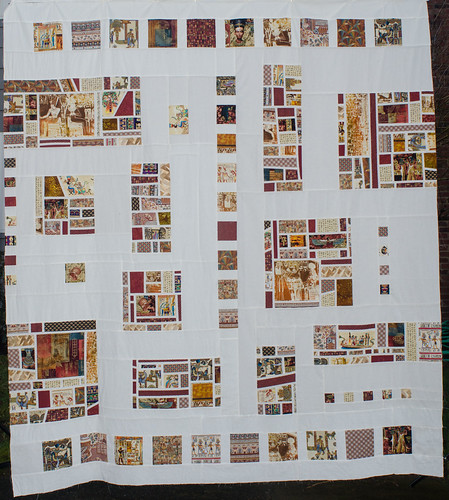

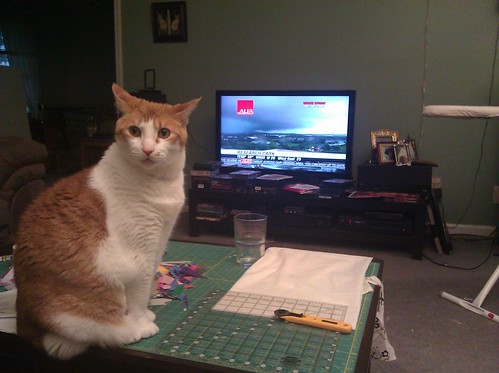



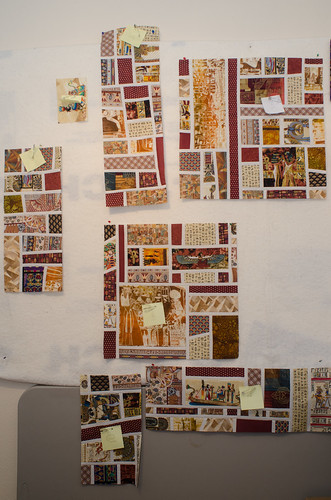


Comments
I look at the variety of
I look at the variety of fabric and find myself wondering if the Fledgling approach would work here.
I'm revisiting this after
I'm revisiting this after reading about Papyrus; in the blog entry on that quilt, there is mention of the old name for this quilt, Desert Rose. Cairo Sunset came up later.
One thing I'm proud of in these fabrics: In the upper-left corner are two batiks. They were picked to provide a color match to the somewhat wild fabric to the right of the solids in the top center of the picture. That fabric has some gold printing on it, but the underlying colors are like mini-ombre patches, and trying to find a solid that worked was impossible where we were. The batiks were very very close.
My earlier comments were from
My earlier comments were from times when this entry only had photos of the fabrics.
I want to add one thing now: Amy didn't include a picture of the overall sewing room. We had one table set up with piles of the fabrics and the sewing machine. We had another table set up with another cutting board and the rulers we were using. There was an ironing board and iron between them, with the design wall making the forth side of the box. I don't think we could have fit in a third person, but we had a system going pretty well.